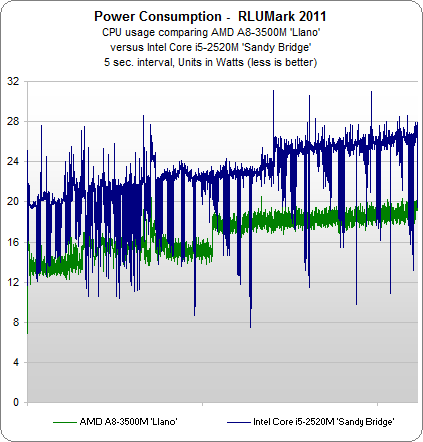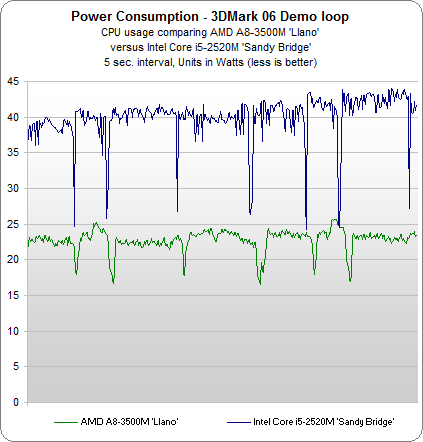The AMD A8-3500M APU Review: Llano Is Unleashed
Code-named Llano, AMD’s first desktop-class APU arrives today. This single-chip combination of the Stars CPU architecture and Radeon graphics brings unique strengths (and weaknesses) to the table, and we’re here to compare them to Intel's Sandy Bridge.
Power Usage And Battery Life
Given AMD’s improved power efficiency claims, we’re naturally interested in Llano’s alacrity here. After all, AMD’s presence in the mobile space is modest. So it’ll take demonstrations of solid battery life to complement respectable performance if the company hopes to make inroads with mobile vendors perpetually pushing smaller form-factors and more run-time.
Our first test is the Tom’s Hardware Real Life Usage (RLU) benchmark, something our own Andrew Ku created. This test simulates actual use by Web browsing, performing Microsoft office tasks, and viewing a DivX movie.
Because we’re benchmarking two laptops with different batteries and screens, we’ve removed those variables by simply measuring power use when outputting to an external monitor.
Based on the chart, you’d expect that the A8-3500M APU would have the advantage over Intel’s Core i5-2520M in general power usage.
But Intel’s processor dips into a low power state more often. This mode-switching results in very similar power numbers. The Core i5-2520M averaged 12.8 watts during Web browsing, 17 watts during office tasks, and 19.4 watts in movie playback. In contrast, the A8-3500M averages 15.2 watts, 16.3 watts, and 19.5 watts, respectively. And while the Core i5 demonstrates faster CPU performance in our benchmarks, that isn’t as much of a factor when you’re surfing the net, typing a document, or playing back a movie. The experience is the same.
Now let’s see how these platforms handle a graphics load:
The power use in the above graph is a result of a controlled test on an external monitor, so we repeated this metric again, this time using the laptop’s own display. The A8-3500M laptop lasted two hours and 12 minutes. Assuming the Intel laptop used the exact same battery, it would run for one hour and 22 minutes.
Get Tom's Hardware's best news and in-depth reviews, straight to your inbox.
This is very impressive. Not only does the A8-3500M get about twice as much time out of its battery, it does so while delivering far better graphics performance. The implications of this are profound: a Llano laptop user might be able to play a mainstream 3D game for an entire two-hour flight with decent frame rates, while the Intel Core i5-based platform would only last for half of the flight with choppy performance. There does, in fact, seem to be validity in AMD’s excitement over its improved power story, and of course this is a real advantage when it comes to mobile devices.
Finally, we wanted to look into the company’s claims about AMD AllDay power. Now, AMD defines “All Day” battery life as 8+ hours in Windows, idling. This is ridiculous, plain and simple. Nobody powers on their system and lets it sit there just to claim it was on from nine to five at work. AMD needs to sit down and let the engineers do their thing. The real-world power figures tell a compelling-enough tale without some marketing-driven buzzword.
On our A8-3500M-based test mule, we did try to see how long the battery would last using the lowest monitor brightness and a very simple workload: document reading. We used the Battery Eater Pro benchmark to simulate someone browsing through a document and the machine lasted 7 hours and 40 minutes. That’s quite a feat for a full-sized laptop running an AMD processor, given the company's track record in the mobile space. The Sabine platform brings the fight to Intel's turf.
Current page: Power Usage And Battery Life
Prev Page HD Video Quality Benchmark: HQV 2.0 Next Page Conclusion: Llano Brings A Lot Of Potential To The TableDon Woligroski was a former senior hardware editor for Tom's Hardware. He has covered a wide range of PC hardware topics, including CPUs, GPUs, system building, and emerging technologies.
-
fstrthnu AMD is kind of in a fix here, the more enthusiast gamers won't even bother looking at the Llano computers while this is kind of overkill for casual gamers. MAYBE money-pressed college students or something, but most people will just skip this and either buy a regular gaming computer or build their own using one of the guides from this very site! Going for good graphics in cheap desktops is kind of a futile exercise, the people who will care will just get the more expensive stuff anyways. Notebooks are more understandable, but the prices on the decent gaming desktops are just too good for Llano to be very competitive (and also, the CPU portion will be a letdown for the average person. Noticeably slower than the comparable Intel Core i5.)Reply -
stingstang Good job, AMD. You finally made a better cpu/gpu combo than intel in terms of graphics power.Reply
....big win there... -
vz7 After reading the desktop benchmarks on anandtech I can't say I'm impressed. The top of the line a8 3850 manages to scratch the best intel integrated graphics, which doesn't say much. Its CPU power seems to be a toss up with the i3. I think this hardly justifies the +70 premium (over an i3) that you'd have to spend to get it.Reply -
billj214 This APU being somewhat low power and good graphics almost deserves to be in a tablet PC since CPU processing is not critical in tablet PC's and graphics is something that can help with media and games.Reply
Ditto on the "Good Job AMD" definitely on the right track. -
cangelini vz7Do you know when the desktop review for llano will be out?Reply
The NDA is up on the 30th. -
niceview two things:Reply
1) What happened to the Game Charts results for the Radeon HD 5570, when the games were benchmarked? I thought you made a point to say you were going to compare the APU's 6620G with a discrete card (that has the same number of SPs and same clock). So much for that, unless you thought only comparing the two with a synthetic test was enough. Oh well. Tom's can be such a tease!
2) I'm just a little disappointed that the APU's graphics power was not able to double Intel's.... Under the best of circumstances, AMD's latest integrated graphics came close to being twice as fast, but i guess that is ok since we are not playing horseshoes. I just thought it would be nice if it had made a nice even doubling, or more. Now, i'm worried IVY BRIDGE will beat it.... -
niceview sorry, i guess that should be:Reply
we ARE playing horseshoes...
and i have to give credit where credit is due: props to AMD for almost doubling Intel's HD Graphics in the integrated space....

